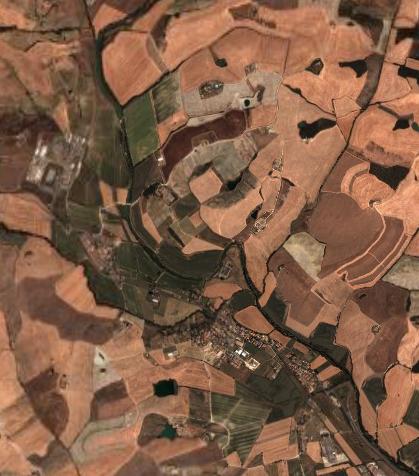
Candida Martinelli's Italophile Site

Main
Page This family-friendly site celebrates Italian culture for the enjoyment of children and
adults. Site-Overview
Saint Vivaldo and Jerusalem of Tuscany
Edith Wharton Goes to San Vivaldo Italian
Backgrounds (Travel Writings) Italian
Villas and Their Gardens (About Italian Villas and their
Renaissance Gardens) In
January 1895, she had an article published, 'A Tuscan Shrine', in
Scribner's Magazine (reprinted in Italian Backgrounds).
In the article she described how she helped reattribute some forgotten, terracotta
sculptures to the famous Della Robbia School of terracotta
art. I
provide here excerpts from her article, with illustrations of what she
wrote about, some from her article, others not. I also provide links below for those
who wish to research the terracottas more, visit San Vivaldo, or read
her entire article. The locals built a shrine by the
hollowed-out tree he lived and died in. Pilgrims came to the
shrine, prayed, and miracles happened. Eventually Friar Vivaldo
was declared Saint (San) Vivaldo. In the
early 1500s, Friar
(Fra) Cherubino of Florence, also of the Franciscan order, supervised the
building of the San Vivaldo monastery and church to honor the saint
and to host pilgrims. San
Vivaldo Monastery courtyard - Interior of San Vivaldo
Church At that
same time, one of the Franciscan monks, Fra Tommaso, who had been to the Holy Land in pilgrimage,
imagined the wood around the monastery to resemble in miniature the
landscape of Palestine. Using
the landscape of the woods as a guide, Fra
Tommaso
mapped out a design for a mini-pilgrimage that would allow pilgrims to recreate a
tour of the holy sites of Jerusalem and her
surrounding areas. At
each point on his map, Fra Tommaso supervised the building and decorating of a
chapel.
Each chapel was filled with art and objects to make each place and event
come alive for the faithful visitors, a sort of Holy Land Theme Park,
to put it crudely. They called it "The Holy Mount" and
also "Jerusalem of Tuscany". Pianta del Sacro Monte con le
indicazioni delle cappelle The
monks who planned and built the San Vivaldo monastery and chapels were
not only a devout group of Franciscans, but an enterprising group.
Fra Cherubino drew in crowds of up to 3000 faithful with his
entertaining outdoor sermons. Then
as payment for an afternoon’s entertainment, he sent the faithful to the
river to bring back building materials for the monastery, church and
chapels. Two
of the Chapels - to give an idea of the size, design and locations Once a
few chapels were built and decorated, the paid tours began.
The monks guided the faithful around the Holy Mount of San
Vivaldo.
They provided stories, homilies and prayers in exchange for
financial support for their monastery. Pilgrims
were replaced over the ages with tourists. Early tourists were wealthy British and Americans
experiencing the Grand Tour of continental Europe.
It seems that all of the writers who traveled, documented their experiences in memoirs and
magazine articles for their less fortunate countrymen who could not
afford the Grand Tour. "For some
months we had been vaguely aware that, somewhere among the hills
between Volterra and the Arno, there lay an obscure monastery
containing a series of terra-cotta groups which were said to represent
the scenes of the Passion. "No
one in Florence, however, seemed to know much about them; and many of
the people whom we questioned had never even heard of San Vivaldo. "Even a
consultation with Professor Enrico Ridolfi, then director of the
‘Royal Museums at Florence (ed. Gli Uffizi) thought there was much to
discover, as local tradition attributed the San Vivaldo terracottas to
a partially blind artist called Gonnelli, from the 1600s, a period
when Italian terracotta art was in decline." She
stubbornly
set out anyway, first by train, then by carriage with an Italian coachman
to San Gimignano where she an her traveling companion, her husband, spent the night.
They set out the next morning before sunrise. "The next
morning before sunrise the little carriage awaited us at the inn-door;
and as we dashed out under the gate-way of San Gimignano we felt the
thrill of explorers sighting a new continent." The
beauty of Tuscany overtook her artistic endeavour.
She waxes prosaic about all she sees, dismissing the rough
four-hour carriage ride as a minor inconvenience. And who can
blame her?! The
View Leaving San Gimignano "The hills, so firmly etched at mid-day, at sunset so softly
modelled, had melted into a silver sea whose farthest waves were
indistinguishably merged in billows of luminous mist.
"Only the near foreground retained its precision of outline, and
that too had assumed an air of unreality. "Fields,
hedges, and cypresses were tipped with an aureate brightness which
recalled the golden ripples running over the grass in the foreground
of Botticelli’s “Birth of Venus.”
"The sunshine had the density of gold-leaf; we seemed to be
driving through the landscape of a missal." "At first
we had this magical world to ourselves, but, as the light broadened,
groups of laborers began to appear under the olives and between the
vines; shepherdesses, distaff in hand, drove their flocks along the
roadside, and yokes of white oxen, with scarlet fringes above their
meditative eyes, moved past us with such solemn deliberateness of step
that fancy transformed their brushwood laden carts into the sacred
caroccio of the past." "Ahead of
us the road wound through a district of vineyards and orchards, but
north and east the panorama of the Tuscan hills unrolled itself, range
and range of treeless undulations outlined one upon the other, as the
sun grew high, with the delicate precision of a mountainous background
in a print of Sebald Beham’s." "Behind
us the fantastic towers of San Gimignano dominated each bend of the
road like some persistent mirage of the desert; to the north lay
Castel Fiorentino, and far away other white villages, embedded like
fossil shells in the hillsides." "The
elements composing the foreground of such Tuscan scenes are almost
always extremely simple--slopes trellised with vine and mulberry,
under which the young wheat runs like green flame; stretches of
ash-colored olive-orchard; and here and there a farmhouse with
projecting eaves and open loggia, sentinelled by its inevitable group
of cypresses." "These
cypresses, with their velvety-textured spires of rusty black, acquire
an extraordinary expressiveness against the neutral-tinted breadth of
the landscape; distributed with the sparing hand with which a practiced
writer uses his exclamation points they seem, as it were,
to emphasize the more intimate meaning of the scene; calling the eyes
here to a shrine, there to a homestead, or testifying by their mere
presence to the lost tradition of some barren knoll." "But this
significance of detail is one of the chief charms of the mid-Italian
landscape. It has none of
the purposeless prodigality, the extravagant climaxes of what is
called “fine scenery;” nowhere is there any obvious largesse to
the eye; but the very reticence of its delicately molded lines, its
seeming disdain of facile effects, almost give it the quality of a
work of art, make it appear the crowning production of centuries of
plastic expression." "This lane,
making a sudden twist, descended abruptly between mossy banks and
brought us out upon a grass-plot before a rectangular monastery
adjoining the church whose bells had welcomed us."
"Here was San Vivaldo, and the chapels we had passed doubtless
concealed beneath their cupolas “more neat than solemn”
the terra-cottas of which we were in search." They did
indeed. With a monk as a
guide, they toured the chapels. There
were roughly 20 chapels, and she mentions that at least that many were
said to have already perished over time.
Some were stripped of major pieces, but others were salvaged by
the monks who had the works whitewashed over before government forces
could steal them during a religious repression of their monastery.
Each chapel had a terracotta set in a recess at the end of the
chapel, decorations in the chapel, and places to pray. And
under Pilate's house, there was even a dungeon where Barabas awaited
his release in place of Jesus. Inside
the Chapel of 'Lo Spasimo' or 'The Swoon/Faint', a depiction of Mary
when she sees Jesus carrying the cross (From sanvivaldointoscana.com,
could you guess?) They
were amazed by the quality of the life-sized terracotta
figures they saw. Some
depicted the Passion, others the lives of Jesus and Mary.
They definitely did not fit the description of late, lesser
works by a minor artist, that they had been led to expect.
She felt the best of the terracottas (and moldings around them
and ceiling decorations) looked to be from the early 1500s and were of high
quality, almost certainly of the Della Robbia School, the epitome of Italian terracotta artwork. “The
careful modelling of the hands, the quiet grouping, so free from a
distorted agitation, the simple draperies, the devotional expression
of the faces, all seemed to me to point to the lingering influence of
the fifteenth century; not, indeed, to the incomparable charm of its
prime, but the refinement, the severity of its close." Edith
Wharton decided that the best of the terracotta reliefs were most
probably by the same artist.
She described these in her article accompanied by black-and-white
photographs. Here's what she had to say about them, with her
accompanying photographs by the Alinari Brothers Studios of
Florence. I provide color images where possible and a comparison
of how they've changed. The
Descent of the Holy Ghost upon the Disciples "The same air of unction, of what the French call recueillement,
distinguishes the face and attitude of the kneeling disciple on the
extreme left; indeed what chiefly struck me in the group was that air
of devotional simplicity which we are accustomed to associate with an
earlier and purer period of art." A
recent image shows some of the painted decoration surrounding the
terracotta figures. It looks like quite a bit of restoration
work has been done to these figures and niche. "Next to
this group the finest is perhaps that of “Lo Spasimo,”
the swoon of the Virgin at the sight of Christ bearing the cross.
… "It is the smallest of the groups, being less than life-size,
and comprising only the figure of the Virgin supported by the Maries,
with a Saint John kneeling at her side.
"In it all the best
attributes of the artist are conspicuous;
careful modelling, reticence of expression, and, above all, that
“gift of tears” which is the last quality we look for in the
plastic art of the seventeenth century." Here
is how the terracotta figure appears today in its niche in its
chapel. The hub-cap-looking halos are missing, which is an
improvement, in my humble opionion, and the niche looks different from
when Edith Wharton saw it. (From of sanvivaldointoscana.com,
in case you didn't notice!) Christ
Before Pilate "In the
group of “Christ Before Pilate” the figure of Pilate is especially
noteworthy; his delicate, incredulous lips seem just framing the
melancholy “What is truth?” As
we stood before this scene our guide pointed out to us the handsome
Roman lector who raises his arm to strike the Savior has had his hand
knocked off by the indignant zeal of the faithful." In
this recent image of "Christ Before Pilate", the stricken
hand of the "handsome Roman lector" about to strike Jesus
has been replaced. It looks like the faithful are less full of
"indignant zeal" these days. You can see the painted and
molded decoration behind and around the figures. Ascension "In the
group of the “Ascension” the upper part has been grotesquely
restored; but the figures of the Virgin and disciples, kneeling below,
are intact. On their
faces is seen that look of wondering ecstasy, “the light which never
was on sea or land” which the artist excelled in representing.
In every group his Saint John has this luminous look; and in
that of the “Ascension” it brightens even the shrewd, bearded
countenances of the older disciples." I don't
have an image of the "Ascension" but this is "The Resurrection"
with Mary Magdalen as the central figure with Jesus in the "Noli
me tangere" position. The disciples are arranged around
them much the same way as described by Edith Wharton for the
"Ascension". Magdalen
Bathing the Feet of Christ "That of Christ and his host are peculiarly expressive; and
Saint John’s look of tranquil tenderness contrasts almost girlishly
with the clustered majesty of the neighboring faces.
"The Magdalen is less happily executed; she is probably by
another hand." This
recent image of the terracotta figures shows that the patterned
background is no longer as it was when Edith Wharton visited, and the
tablecloth looks restored. There
also seems to have been a change over the heads Jesus (no halo now)
and Simone Fariseo (hat decor stands up now - first to Jesus's left),
and the head of Saint John (the third to Jesus's left) is very-much altered.
It looks like it may have fallen off and been glued back on facing a
different direction! Poor Saint John no longer has a
"look of tranquil tenderness" but more the look of someone
with Attention Deficit Disorder. Jesus
has gained two fingers on his right hand, and the scented oil pot is
different. Could the silver-looking one have gone missing with a
pilgrim? I certainly hope not. The
Crucifixion She
mentions with praise by name only one other work, "The
Crucifixion", and
says she believes it to be by another artist, but wonders if the
thieves are by the better artist. "In the
group of the “Crucifixion,” for the most part of inferior
workmanship, the figures of the two thieves are finely modelled, and
their expression of anguish has been achieved with the same sobriety
of means which marks all the artist’s effects." Here
you can see very clearly the painted backgrounds that back many of the terracotta figures. "The
remaining groups in the chapels are without merit, but under the
portico of the church there are three fine figures, possibly by the
same artist, representing Saint Roch, Saint Linus of Volterra, and
one of the Fathers of the Church." Giovanni Della Robbia
was the son of the famous Luca Della
Robbia. The work is from 1521, around the same period she
suspected the San Vivaldo terracottas were really from, and with many
stylistic similarities. She
provided this black-and-white image with the article. I've been
unable to get an image of the Presepio that is still in the
Bargello Museum in Florence. But I have been able to find an image
of a Nativty done by the same artist in the same period, so you can get an
idea of the colors that were used. (see below) "…I was
startled, on seeing it, by the extraordinary resemblance of the heads
to some of those in the groups ascribed to Gonnelli.
I had fancied that the modeller of San Vivaldo might have been
inspired by the “Presepio;” but I was unprepared for the absolute
identity of treatment in certain details of the hair and drapery, and
for the recurrence of the same type of face.
"Undoubtedly, the “Presepio” shows greater delicacy of
treatment; but then the figures are smaller, and it is a relief,
whereas at San Vivaldo the figures are so much detached from the
background that they may be regarded as groups of statuary. "Then the glaze which covers all but the faces of the
“Presepio” has preserved its original beauty of coloring, while
the groups of San Vivaldo have been crudely daubed with fresh coats
of paint, and even whitewash; and lastly, the “Presepio” is
enhanced by an excessively ornate frame of fruit-garlanded
pilasters, as well as by its charming predella, subdivided by panels
of arabesque." This
'Nativity' is also by Giovanni Della Robbia in the same period and is
in The Hermitage museum in St. Petersburg. The scene is very
similar especially in the background such as the roof and
angels. There are also similarities in the decorative frame top
and sides. "Altogether
it is a far more elaborate production than the terra-cottas of San
Vivaldo, and some of its most graceful details, such as the dance of
angels on the stable roof, are evidently borrowed from the earlier
repertoire of the Robbias; but, in spite of these incidental
archaisms, who can fail to be struck by the likeness of the central
figures to certain of the statues at San Vivaldo?
"The head of Saint Joseph, in the “Presepio,” for instance,
with its wrinkled penthouse forehead and curled and parted beard,
suggests at once that of the disciple seated on the right of Saint
John in the house of the Pharisee; the same face, though younger,
occurs again in the Pentecostal group, and the kneeling female figure
in the “Presepio” is treated in the same manner as the youngest
Mary in the group of “Lo Spasimo.”
Even the long, rolled-back tresses, with their shell-like
convolutions are the same." He concurred with her that the
terracottas were from a century
earlier (the early 1500s) than they had up to then been attributed,
and that they were certainly of the Della Robbia School and of a very high quality.
He also identified the Presepio in the Bargello as the
San Vivaldo Presepio.
Thanks
to the efforts of Italophile Edith Wharton, the terracottas of
San Vivaldo began their climb in artistic and tourism importance. A
Tuscan Shrine in Scribner's Magazine, January 1895 Images
of the Chapels from John Vales of Tuscany Images
of the Terracottas from John Vales of Tuscany The
Comune di Montaione site's pages about San Vivaldo Montaione,
the area where San Vivaldo resides, has a very informative website The
Montaione site has this page all about San Vivaldo San
Vivaldo has this site in Italian all about the monastery and chapels You can visit San Vivaldo,
the town, monastery and chapels. You
can even enjoy free open-air classical music concerts every Sunday in
summer. The
Sacro Monte di Varese boasts later chapels and more elaborate
decorations. The
chapel idea to convey the life of Jesus was used by other churches,
and Passion pilgrimages were very popular in Italy from the middle
ages onward. Even today, there are some towns in Southern Italy
that re-enact the Passion Play every Easter. Another
site for virtual tours of Sacro Monte di Varese And
there is another: Sacro
Monte di Varallo Sesia with 43 chapels in a beautiful nature
reserve in Piedmont (Piemonte). The chapels are decorated with
frescos and lots of life sized statues. Summary
of Italian Backgrounds from the Edith Wharton Society Summary
of Wharton's Italian Villas and Their Gardens from the Edith
Wharton Society
This
unusual image is the Chianti area from space, courtesy of
GoogleEarth. You can clearly see the golden and green
patchwork of fertile fields that give Chianti it's famous golden
glow.
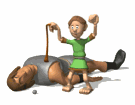
Edith
Wharton, the Italophile who put the San Vivaldo Terracottas on
the artistic and tourism map
![]()
Edith
Wharton, Italophile
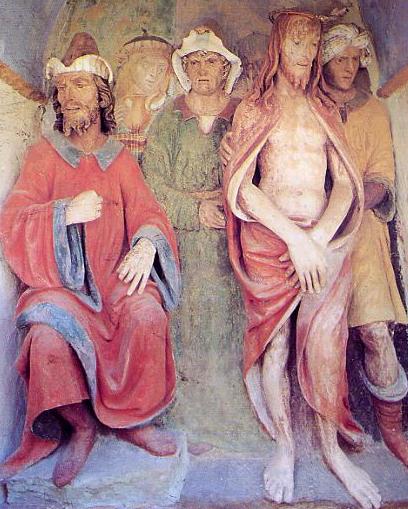 Edith
Wharton wrote often about Italy. She lived and died in France, but she
loved Italy's art and landscapes. She published two books about
Italy:
Edith
Wharton wrote often about Italy. She lived and died in France, but she
loved Italy's art and landscapes. She published two books about
Italy:
Saint
Vivaldo and Jerusalem of Tuscany
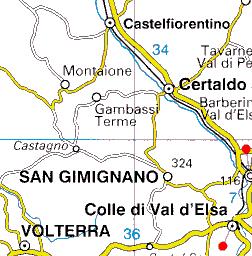 Saint
Vivaldo of San Gimignano lived in the late 1200s. He was a
Franciscan monk and later a hermit who withdrew to and died in a forest
outside of San Gimignano in the area called Montaione. (Image
right: Montaione north-west of San Gimignano, Florence is east of
Certaldo.)
Saint
Vivaldo of San Gimignano lived in the late 1200s. He was a
Franciscan monk and later a hermit who withdrew to and died in a forest
outside of San Gimignano in the area called Montaione. (Image
right: Montaione north-west of San Gimignano, Florence is east of
Certaldo.)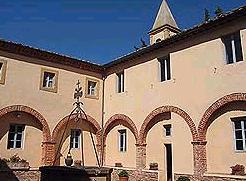
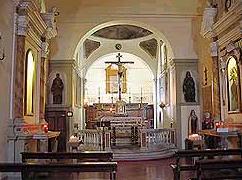

1. La chiesa A. Sacrestia B. Chiostro grande C. Lavatoio 2. Museo del
Sacro Monte 3. Cenacolo 4. Casa di Anna 5. Cappella dell'Annunciazione
6. Cappella della Fuga in Egitto 7. Casa di Simone Fariseo 8. Casa di
Pilato 9. Casa di Erode 10. Cappella dell'Andata al Calvario 11.
Chiesa dello Spasimo 12. Cappella delle Pie Donne 13. Casa della
Veronica 14. Cappella del Calvario 15. Edicola del Santo Sepolcro 16.
Cappella del Noli Me Tangere 17. Cappella del Carcere di Cristo 18.
Cappella di San Giacomo 19. Casa di Caifa 20. Valle di Giosafat 21.
Cappella dell'Ascensione
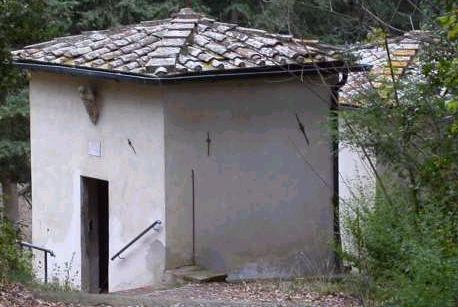
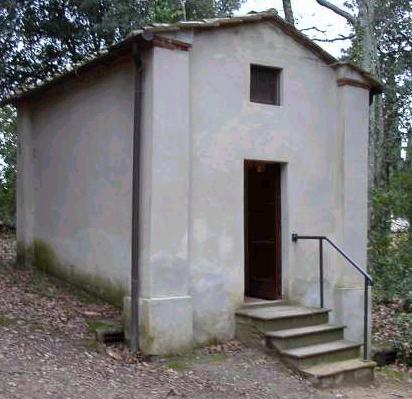
Edith
Wharton Goes to San Vivaldo
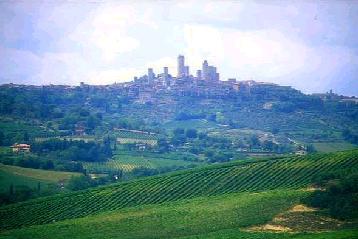 Edith
Wharton was just such a travel-writer. In
'A Tuscan Shrine' she describes the beginning to her trip to San
Vivaldo via medieval San Gimignano.
Edith
Wharton was just such a travel-writer. In
'A Tuscan Shrine' she describes the beginning to her trip to San
Vivaldo via medieval San Gimignano. She's
Distracted by the Beauty of Tuscany
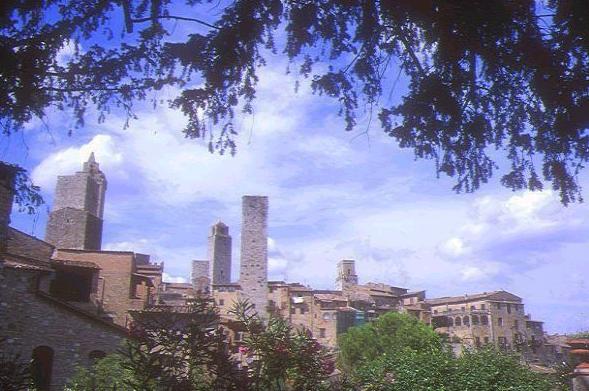
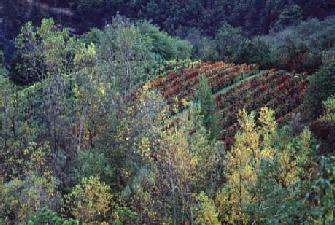 "It
seemed in fact an unknown world which lay beneath us in the new light.
"It
seemed in fact an unknown world which lay beneath us in the new light.
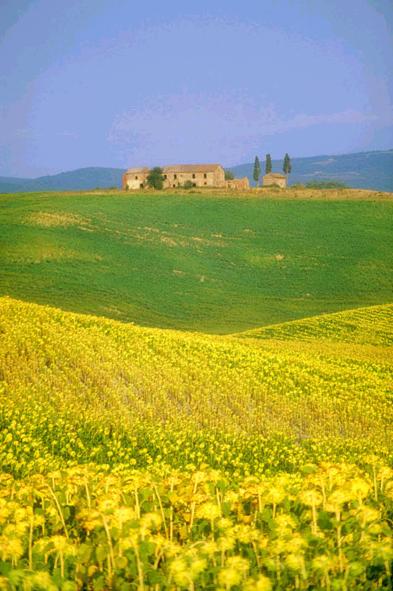
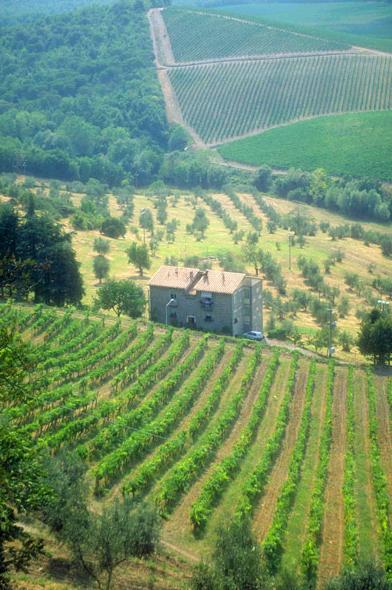


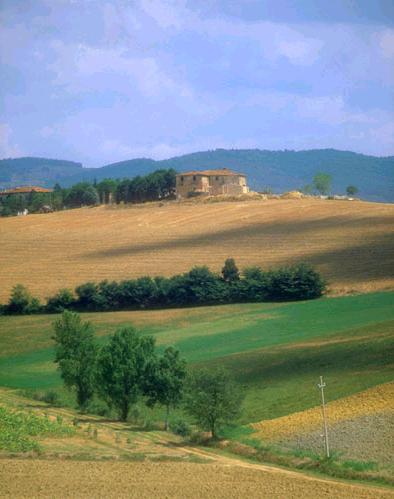
She
Arrives at San Vivaldo
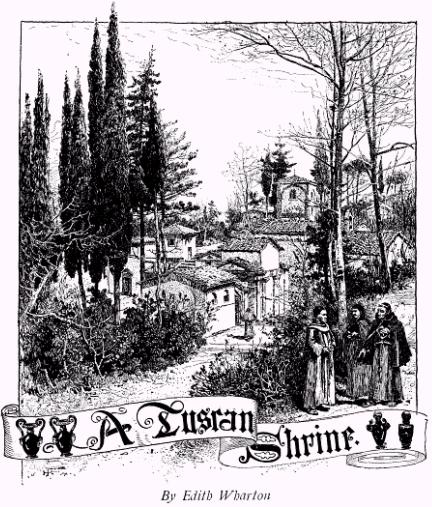 "…we
caught sight of a brick campanile rising above oaks and ilexes on a
slope just ahead of us, and our carriage turned from the high-road up
a lane with scattered chapels showing their white facades through the
foliage. (Image to right: a drawing that accompanied the article, depicting the view described.)
"…we
caught sight of a brick campanile rising above oaks and ilexes on a
slope just ahead of us, and our carriage turned from the high-road up
a lane with scattered chapels showing their white facades through the
foliage. (Image to right: a drawing that accompanied the article, depicting the view described.) 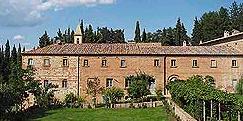
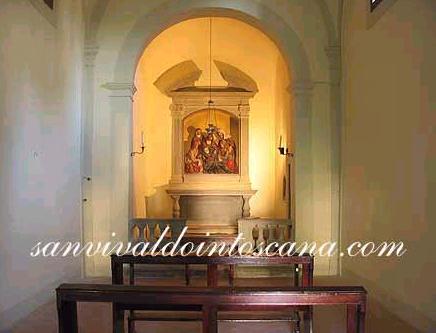

Her
Favorite Terracottas
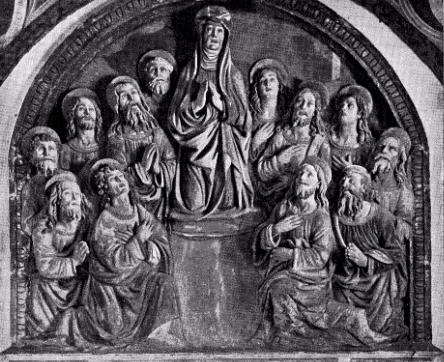 "The
central figure, that of the Virgin, is one of the most graceful at San
Vivaldo; her face austerely tender, with lines of grief and age
furrowing the wimpled cheeks; her hands, like those of all the figures
attributed to Gonnelli, singularly refined and expressive.
"The
central figure, that of the Virgin, is one of the most graceful at San
Vivaldo; her face austerely tender, with lines of grief and age
furrowing the wimpled cheeks; her hands, like those of all the figures
attributed to Gonnelli, singularly refined and expressive.

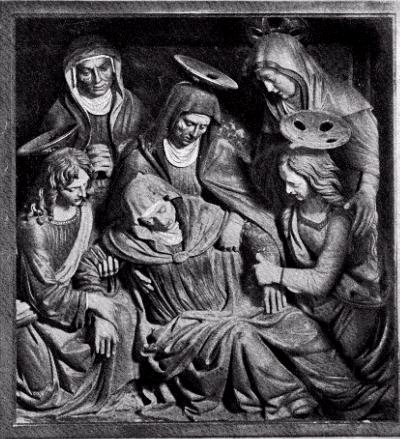 Lo
Spasimo
Lo
Spasimo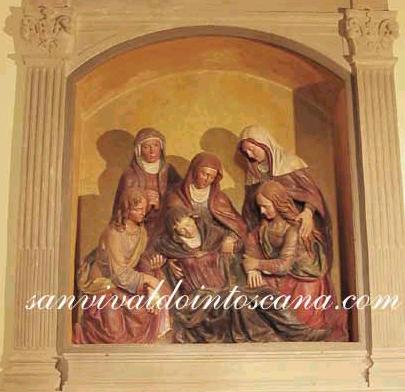


 "The
representation of the “Magdalen Bathing the Feet of Christ” (ed.: La
Casa di Simone Fariseo) is
noticeable for the fine assemblage of heads about the supper-table.
"The
representation of the “Magdalen Bathing the Feet of Christ” (ed.: La
Casa di Simone Fariseo) is
noticeable for the fine assemblage of heads about the supper-table.
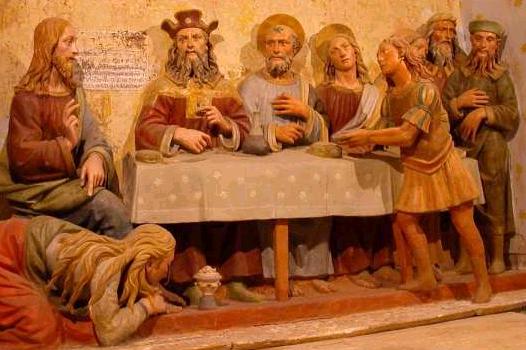
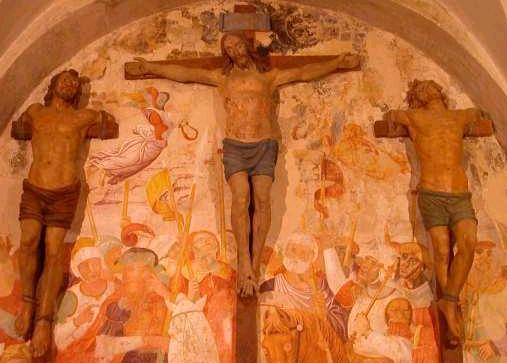
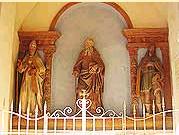 She
also mentions three works on the outside of the Church of San
Vivaldo which still stand today:
She
also mentions three works on the outside of the Church of San
Vivaldo which still stand today:The
San Vivaldo Presepio
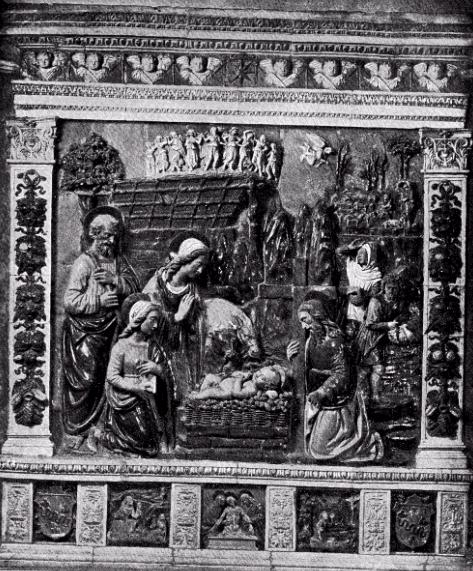 Only the
Presepio, crèche or Nativity Scene, was taken and never
returned, they
were told. However, Edith Wharton recognized the missing Presepio
in
the collection in Florence’s Bargello museum. There it was
attributed to Giovanni Della Robbia of the Della Robbia school.
Only the
Presepio, crèche or Nativity Scene, was taken and never
returned, they
were told. However, Edith Wharton recognized the missing Presepio
in
the collection in Florence’s Bargello museum. There it was
attributed to Giovanni Della Robbia of the Della Robbia school. 
Re-attribution
to the Della Robbia School
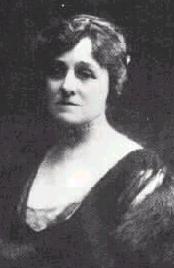 Convinced
the terracottas were incorrectly attributed, Edith
Wharton arranged for a photographer to travel to San Vivaldo to
photograph the terracottas. Then
she sent the photos to the museum director to study.
Convinced
the terracottas were incorrectly attributed, Edith
Wharton arranged for a photographer to travel to San Vivaldo to
photograph the terracottas. Then
she sent the photos to the museum director to study.
Some
Interesting Links
Edith
Wharton's Italy Books
